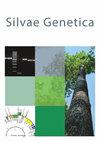基于交叉可转移性的西喜马拉雅栎树SSR标记鉴定与验证
IF 1
4区 农林科学
Q3 FORESTRY
引用次数: 2
摘要
摘要交叉扩增是将SSR标记的适用性扩展到亲缘关系密切但缺乏自身序列信息的类群的一种经济有效的方法。本研究对来自欧洲、北美和亚洲的4种栎树的35个SSR标记进行了筛选,并对喜玛拉雅西部5种栎树进行了筛选。在半栎中成功扩增到15个标记,在花栎和白栎中分别扩增到11个标记,在青松中扩增到10个标记,在白栎中扩增到9个标记。除半山毛兰的2对引物外,其余引物均存在多态性。大部分正交叉扩增的ssr来源于亚洲栎(Q. mongolica)。在5种目标树种中,QmC00419多态性最显著,QmC00716多态性最显著,QmC01368多态性最显著,QmC02269多态性最显著。5种栎树中,白栎和半胡桃栎的基因多样性最高(He = 0.72),白栎和青栎的基因多样性最低(He = 0.65)。本文验证的ssr为进一步开展西喜马拉雅地区橡树种群遗传分析提供了宝贵的资源。本文章由计算机程序翻译,如有差异,请以英文原文为准。
Cross-transferability-based identification and validation of simple sequence repeat (SSR) markers in oaks of western Himalayas
Abstract Cross-amplification is a cost-effective method to extend the applicability of SSR markers to closely related taxa which lack their own sequence information. In the present study, 35 SSR markers developed in four oak species of Europe, North America and Asia were selected and screened in five species of the western Himalayas. Fifteen markers were successfully amplified in Quercus semecarpifolia, followed by 11 each in Q. floribunda and Q. leucotrichophora, 10 in Q. glauca, and 9 in Q. lana-ta. Except two primer pairs in Q. semecarpifolia, all were found to be polymorphic. Most of the positively cross-amplified SSRs were derived from the Asian oak, Q. mongolica. The genoty-ping of 10 individuals of each species with positively cross-amplified SSRs displayed varied levels of polymorphism in the five target oak species, viz., QmC00419 was most polymorphic in Q. floribunda, QmC00716 in Q. glauca and Q. lanata, QmC01368 in Q. leucotrichophora, and QmC02269 in Q. semecarpifolia. Among five oak species, the highest gene diversity was depicted in Q. lanata and Q. semecarpifolia with expected heterozygosity (He = 0.72), while the minimum was recorded for Q. leucotrichophora and Q. glauca (He = 0.65). The SSRs validated here provide a valuable resource to carry out further population genetic analysis in oaks of the western Himalayas.
求助全文
通过发布文献求助,成功后即可免费获取论文全文。
去求助
来源期刊

Silvae Genetica
农林科学-林学
CiteScore
2.20
自引率
10.00%
发文量
10
审稿时长
3 months
期刊介绍:
Silvae Genetica is an international peer reviewed journal with more than 65 year tradition and experience in all fields of theoretical and applied Forest Genetics and Tree breeding. It continues "Zeitschrift für Forstgenetik und Forstpflanzenzüchtung" (Journal of Forest Genetics and Forest Tree Breeding) founded by W. LANGNER in 1951.
 求助内容:
求助内容: 应助结果提醒方式:
应助结果提醒方式:


